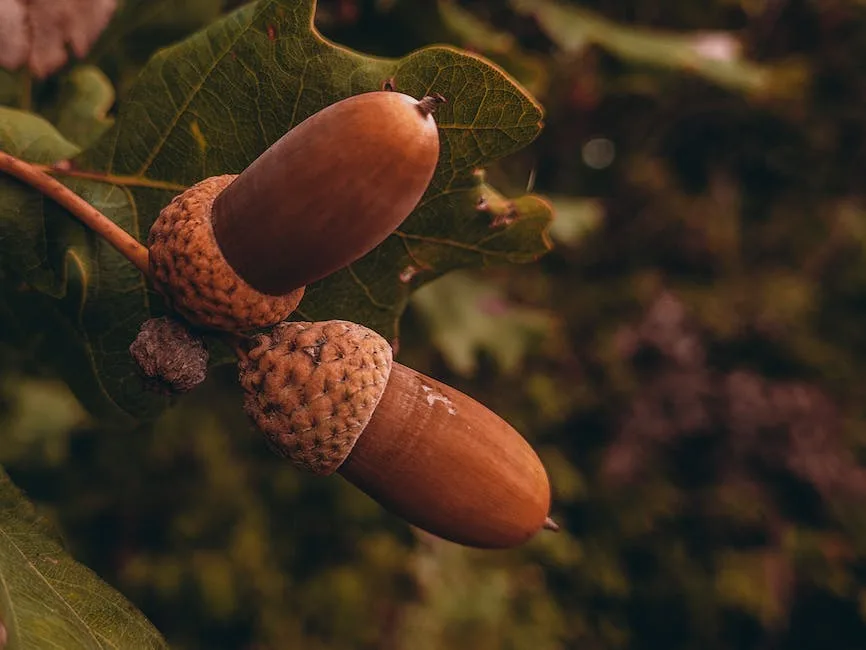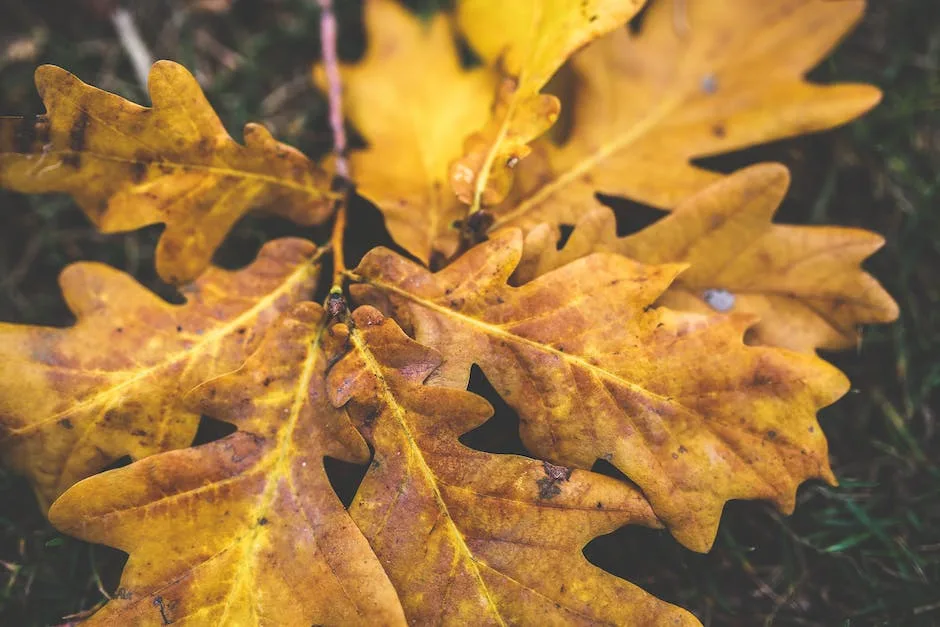As the leaves of summer begin to fade and the cool breezes of autumn start to blow, many trees prepare for winter by shedding their leaves. For some trees, like oaks, this process is gradual, with leaves falling throughout the season. Other trees, like maples, drop their leaves all at once in a spectacular display. But why do trees lose their leaves?
Some oak trees lose their leaves in the fall, while others do not.
What does a oak tree look like in the fall?
The American beech is a deciduous tree that is native to the eastern United States. Under the right conditions, their fall foliage can be a reddish-brown color that is especially rich on young trees. Their leaves are between 4 and 9 inches long with seven to nine lobes. They start a pinkish color in the spring and transition to dark green. The trees can reach 80 feet tall with a similar spread.
Leaves falling from trees is a natural process that happens when the leaves are no longer connected to the tree. This can be caused by changes in the environment, such as shorter days or stress from diseases. Marcescence is when this process is interrupted and leaves stay on the tree.
Do oak trees keep their leaves all winter
There are a few trees that are known for dropping their leaves in autumn, but most trees actually drop their leaves in spring. This is because new leaf growth pushes off the older leaves. While the leaves may be falling off the tree, the tree is still alive and well.
As the days get shorter and the temperatures start to drop, trees begin to prepare for winter. They do this by breaking down the pigments and nutrients in their leaves, which produces the beautiful autumn colors. Once the nutrients are extracted, the leaves are shed.
What happens to oak trees in autumn?
It’s autumn, and the oak tree is shedding its leaves and acorns. The leaves change colour and fall, while the acorns simply fall to the ground. Over time, the oak tree will replenish its supply of leaves and acorns, but for now, it’s a time of change.
Oak trees tend to be the last holdouts in the fall, giving you color and interest later in the season. Their deeper shades of russet, red, and yellow-brown can really add depth and dimension to your landscape. Plus, they’re just plain beautiful to look at!
What oaks dont lose leaves?
It’s not entirely clear why some trees keep their dead leaves while others don’t, but it’s thought that it could be an adaptation to help with water retention or to protect the tree from frost damage. Marcescent leaves are found mostly on trees in the Midwest, but can be found in other parts of the world as well.
A boom time, or mast year, is a time when oak trees produce an abnormally large number of acorns. This happens every 2-5 years, and during these years, the trees produce acorns that are larger and more abundant than during non-mast years. The acorns mature in late summer and start falling from the trees in September or October.
Are oak trees evergreen or deciduous
Most oak trees are deciduous, which means that they lose their leaves in the fall. The leaves of an oak tree are green during the spring and summer, but they turn yellow, orange, and red during the fall. There are over four hundred different types of oak trees. Some are evergreen, but most are deciduous.
The ‘Quercus ilex’ is a type of oak tree that is known for its dark green, glossy leaves that it holds all year round. This tree is also known as the Evergreen Oak. The ‘Quercus ilex’ is a native tree to the Mediterranean region and is one of the most common oak trees found in this area.
Can you leave oak leaves on the ground?
Autumn leaves are an important part of the natural cycle of trees and plants. They provide a valuable source of nutrients and organic matter for the soil, and are an important part of the carbon cycle.
Leaving leaves on the ground is the best way to reduce greenhouse gases and benefit your garden. Leaves create a natural mulch that helps to suppress weeds while fertilizing the soil as it breaks down. This process of decomposition is essential for healthy ecosystems, and is much more efficient when leaves are left in place.
In addition to the benefits for the soil, leaving leaves also provides homes and food for many animals such as insects, small mammals, and birds. This is particularly important in urban areas where natural habitats are limited.
So next time you’re tempted to rake up those leaves, think about the benefits of leaving them be!
The life span of oaks varies according to the species of oak. The average life span is about 100 – 300 years, but particular species can live for shorter or longer times. The water oak (Quercus nigra), native to the southeastern United States, lives for only 30 to 50 years and the laurel oak (Q. laurifolia), also from the southeastern United States, can live for 500 years or more.
Do oak trees drop every year
It is not uncommon for the acorn crop on oak trees to vary from year to year. Most oak species produce a good crop of acorns once every two or three years. However, the white oak tends to produce a good acorn crop once every four to six years. Weather and other factors can affect flowering and fruiting.
A typical English oak tree starts producing acorns at around 40 years old, peaking in productivity around 80-120 years Oaks, in general, can be productive for 300 years then rest for 300 years before moving on in the life cycle.
Do oak trees go dormant in the winter?
Most deciduous oaks don’t begin changing color until November, when the days start getting shorter and the temperatures start to drop. This signals to the tree that winter is coming and it’s time to start getting ready for dormancy.
Trees are always shedding leaves, bark, and twigs. As they grow, they add new Growth. This process is necessary for the tree to stay healthy and continue to thrive. If a tree stops shedding, it will become overgrown and unhealthy.
Are oak trees male or female
Oaks are monoecious, which means that both the male (staminate) and female (pistillate) flowers are on the same tree. This is an important characteristic of oaks, as it allows for self-pollination and greater reproductive success.
This is a beautiful tree that is perfect for adding some color to your landscape. The leaves are dark green to slightly blue-green in summer, but then they change to a variety of fall colors including brown, wine-red, and orange-red. The fall foliage is showy and really makes this tree stand out.
What tree keeps leaves all year
Evergreen trees are an excellent choice for property owners who want year-round landscape beauty with little maintenance required. These versatile trees come in a variety of shapes and sizes, making it easy to find one that will fit your particular space and needs. Whether you choose a small, delicate evergreen for your front yard or a towering one for your backyard, you can be sure that your evergreen will make a lasting impression.
While oak can technically grow in both full sunlight and deep shade, it doesn’t thrive in either condition. It grows best in partial sun/partial shade and rich soils.
What tree keeps its leaves all winter
Marcescence is the retention of leaves by a tree through the winter months. Many species of trees exhibit this to some degree, with beech being the most common. Oak and hornbeam are also among the species that often retain their leaves. Marcescence helps trees to protect their buds and keep them from being damaged by cold weather. It also allows trees to take in more sunlight and helps to insulate them against the cold.
The White Oak is a superior shade tree that grows 12′-15′ over a 10 to 12 year period, eventually reaching a height of 80 feet or more. Its fall color is brown to rich red, and its acorns are a preferred food source for many mammals and larger birds.
Why are oak trees so strong
Oaks are one of the most interesting trees due to their deep and wide-reaching root systems. This allows them to withstand strong storms, such as tornados and hurricanes.
If you plan to eat acorns, it is important to leach them first to remove the tannins. Tannins are toxic to humans and can cause an unpleasant bitter taste. They are also poisonous to horses, cattle and dogs. However, by leaching acorns to remove the tannin, they can be made safe for human consumption.
Which country has the most oak trees
According to a study, North America has the largest number of oak species. In fact, there are approximately 160 species of oaks in Mexico. Of these, 109 are endemic. In the United States, there are about 90 different oak species. The second greatest area of oak diversity is China, with an estimated 100 different species.
Researchers believe that the incredibly long lifespan of oak trees is due to their deep root systems, which allow them to access water and nutrients that other trees cannot. Additionally, their thick bark protects them from fire and insect damage.Oak trees are a defining species of the forests of the eastern United States, and their longevity adds to their importance. Not only do they provide homes and habitats for many animals, but they also help to stabilize the soil and prevent erosion. If you’re lucky enough to have an oak tree on your property, cherish it, as it may be around long after you’re gone!
Final Words
Yes, most oak trees lose their leaves in the fall. Some oak trees are evergreen, but these are not common.
Based on the information provided, it appears that oak trees do lose their leaves in the fall. This is likely due to the change in seasons and the colder temperatures that come with fall and winter.
Jackson Hill is a passionate arborist with years of experience in the field of trees. He developed his fascination with trees at a young age, spending countless hours exploring the forests and climbing trees. Jackson went on to study arboriculture and horticulture at Michigan State University and later earned a degree in forestry from the University of Michigan.
With his extensive knowledge and expertise, Jackson has become a trusted authority on trees and their impact on the environment. His work has helped shape the field of arboriculture and he continues to be a leading voice in the industry.
